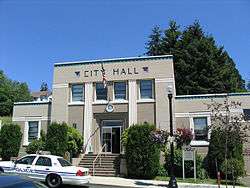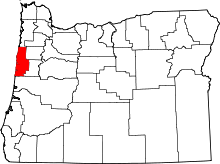Toledo, Oregon
| Toledo, Oregon | |
|---|---|
| City | |
|
The city hall building in Toledo | |
 Location in Oregon | |
| Coordinates: 44°37′17″N 123°56′18″W / 44.62139°N 123.93833°WCoordinates: 44°37′17″N 123°56′18″W / 44.62139°N 123.93833°W | |
| Country |
|
| State |
|
| County | Lincoln |
| Incorporated | 1905 |
| Government | |
| • Mayor | Billie Jo Smith |
| Area[1] | |
| • Total | 6.2 km2 (2.41 sq mi) |
| • Land | 5.6 km2 (2.18 sq mi) |
| • Water | 0.6 km2 (0.23 sq mi) |
| Elevation | 50 m (180 ft) |
| Population (2010)[2] | |
| • Total | 3,465 |
| • Estimate (2012[3]) | 3,462 |
| • Density | 613.7/km2 (1,589.4/sq mi) |
| Time zone | PST (UTC-8) |
| • Summer (DST) | PDT (UTC-7) |
| ZIP code | 97391 |
| Area code(s) | 541 |
| FIPS code | 41-74000[4] |
| GNIS feature ID | 2412076 |
| Website | www.cityoftoledo.org |
| Coordinates and elevation from the Geographic Names Information System of the United States Geological Survey[5] | |
Toledo is a city located on the Yaquina River and along U.S. Route 20 in Lincoln County, in the U.S. state of Oregon. The population was 3,465 at the 2010 census. The city was a 2009 All-America City Award finalist.[6]
History
European-American settlement in Toledo began in 1866, when John Graham,[7] his son Joseph, and William Mackey, claimed land made available by the Homestead Act. The site was called "Graham's Landing" until a post office was established two years later.[7] Joseph D. Graham, John's son, named the post office for Toledo, Ohio, because he was homesick.[7] William Mackey was the first postmaster.[7]
Toledo was made the county seat of the newly established Lincoln County in 1893.[8] The city incorporated in 1893 and reincorporated in 1905.[8] Charles Barton Crosno served as the first mayor.[9] The county seat moved from Toledo to Newport in 1953.[8]
In 1918, the Port of Toledo leased land to the Spruce Production Division for a sawmill to cut airplane frames for World War I. However, before production began, the war ended.[10] C. D. Johnson and associates then bought the mill and related equipment, which by 1923 processed logs shipped to Toledo by rail. Georgia-Pacific acquired the operation in 1951 and turned it into a pulp mill.[10]
Geography
According to the United States Census Bureau, the city has a total area of 2.41 square miles (6.24 km2), of which, 2.18 square miles (5.65 km2) is land and 0.23 square miles (0.60 km2) is water.[1]
Demographics
| Historical population | |||
|---|---|---|---|
| Census | Pop. | %± | |
| 1900 | 302 | — | |
| 1910 | 541 | 79.1% | |
| 1920 | 678 | 25.3% | |
| 1930 | 2,187 | 222.6% | |
| 1940 | 2,288 | 4.6% | |
| 1950 | 2,323 | 1.5% | |
| 1960 | 3,053 | 31.4% | |
| 1970 | 2,818 | −7.7% | |
| 1980 | 3,151 | 11.8% | |
| 1990 | 3,174 | 0.7% | |
| 2000 | 3,472 | 9.4% | |
| 2010 | 3,465 | −0.2% | |
| Est. 2015 | 3,511 | [11] | 1.3% |
2010 census
As of the census[2] of 2010, there were 3,465 people, 1,331 households, and 907 families residing in the city. The population density was 1,589.4 inhabitants per square mile (613.7/km2). There were 1,474 housing units at an average density of 676.1 per square mile (261.0/km2). The racial makeup of the city was 89.9% White, 0.6% African American, 3.8% Native American, 0.5% Asian, 0.1% Pacific Islander, 1.2% from other races, and 3.9% from two or more races. Hispanic or Latino of any race were 4.7% of the population.
There were 1,331 households of which 33.9% had children under the age of 18 living with them, 47.5% were married couples living together, 14.2% had a female householder with no husband present, 6.5% had a male householder with no wife present, and 31.9% were non-families. 22.7% of all households were made up of individuals and 6.1% had someone living alone who was 65 years of age or older. The average household size was 2.60 and the average family size was 3.02.
The median age in the city was 37.6 years. 24.8% of residents were under the age of 18; 8.8% were between the ages of 18 and 24; 26.2% were from 25 to 44; 28.5% were from 45 to 64; and 11.8% were 65 years of age or older. The gender makeup of the city was 48.7% male and 51.3% female.
2000 census
As of the census[4] of 2000, there are 3,472 people in the city, organized into 1,312 households and 926 families. The population density is 1,602.2 people per square mile (617.8/km²). There are 1,474 housing units at an average density of 680.2 per square mile (262.3/km²). The racial makeup of the city is 91.88% White, 3.37% Native American, 0.58% Asian, 0.23% African American, 0.03% Pacific Islander, 0.52% from other races, and 3.40% from two or more races. 2.59% of the population are Hispanic or Latino of any race.
There are 1,312 households out of which 37.7% have children under the age of 18 living with them, 51.5% are married couples living together, 14.0% have a female householder with no husband present, and 29.4% are non-families. 23.0% of all households are made up of individuals and 9.5% have someone living alone who is 65 years of age or older. The average household size is 2.65 and the average family size is 3.05.
In the city the population is spread out with 29.6% under the age of 18, 6.9% from 18 to 24, 32.0% from 25 to 44, 20.9% from 45 to 64, and 10.6% who are 65 years of age or older. The median age is 34 years. For every 100 females there are 97.4 males. For every 100 females age 18 and over, there are 92.7 males.
The median income for a household in the city is $34,503, and the median income for a family is $39,597. Males have a median income of $35,104 versus $22,297 for females. The per capita income for the city is $14,710. 19.3% of the population and 18.6% of families are below the poverty line. Out of the total population, 26.6% of those under the age of 18 and 8.9% of those 65 and older are living below the poverty line.
Education
There are two public schools in Toledo, which are part of the Lincoln County School District: Toledo Elementary School (K–6) and Toledo High School (7–12). Toledo High School is a combination junior high and high school, and serves students in seventh through twelfth grade.[13]
Transportation
Toledo is the western terminus of a Portland and Western Railroad line, once part of the Oregon Pacific Railroad, that links the city to Albany in the Willamette Valley.[14] The city is also served by the port authority (the Port of Toledo), and Toledo State Airport.
References
- 1 2 "US Gazetteer files 2010". United States Census Bureau. Retrieved 2012-12-21.
- 1 2 "American FactFinder". United States Census Bureau. Retrieved 2012-12-21.
- ↑ "Population Estimates". United States Census Bureau. Retrieved 2013-06-02.
- 1 2 "American FactFinder". United States Census Bureau. Retrieved 2008-01-31.
- ↑ "City of Toledo". Geographic Names Information System. United States Geological Survey. March 11, 2008. Retrieved November 24, 2014.
- ↑ "Oregon Town Named All-America City Finalist". Portland Business Journal. April 2, 2009. Retrieved November 24, 2014.
- 1 2 3 4 McArthur, Lewis A.; McArthur, Lewis L. (2003) [1928]. Oregon Geographic Names (7th ed.). Portland, Oregon: Oregon Historical Society Press. p. 961. ISBN 978-0875952772.
- 1 2 3 Hitchman, James H. (2010). "The Port of Toledo, Oregon: 1910–2010" (PDF). Port of Toledo. p. 5. Retrieved November 24, 2014.
- ↑ Portrait and Biographical Record of Western Oregon
- 1 2 Hitchman, James H. (2014). "Port of Toledo". The Oregon Encyclopedia. Portland State University and the Oregon Historical Society. Retrieved November 24, 2014.
- ↑ "Annual Estimates of the Resident Population for Incorporated Places: April 1, 2010 to July 1, 2015". Retrieved July 2, 2016.
- ↑ "Census of Population and Housing". Census.gov. Retrieved June 4, 2015.
- ↑ Toledo High 7–12 from the Lincoln County School District website
- ↑ Gordon, Gregg. "Corvallis and Eastern Railroad". Oregon Encyclopedia. Portland State University and the Oregon Historical Society. Retrieved 2014-11-21.
External links
| Wikimedia Commons has media related to Toledo, Oregon. |
- Entry for Toledo in the Oregon Blue Book
- Historic images of Toledo from the Salem Public Library Historic Photograph Collection

